Disclosure: Meeple Mountain received a free copy of this product in exchange for an honest, unbiased review. This review is not intended to be an endorsement.
To prepare for the latest creation from Stonemaier Games, Red Rising, I thought it would be cool to read at least the first novel in the series which they based the game upon.
The first book is exceptional. A friend of mine noted that the series has notes of The Hunger Games, the Harry Potter books, and Lord of the Flies. However, I thought Red Rising felt closer to Dune (which I recently re-read to get ready for the Denis Villaneuve movie coming out this fall) because of the “house” politics, the slight twist on the English language while still being accessible, a sprinkle of the Blade Runner films and even a taste of season one of the Netflix series Altered Carbon because of the human augmentation elements of that series.
Stonemaier provided Red Rising Collector’s Edition for review, and like other Stonemaier products (I’m a big fan of Scythe, Between Two Cities and Viticulture), the production quality is excellent. It has truly exquisite playing cards; the foil on the Gold suit of cards is ridiculously cool. The components have real weight to them. The iconography’s clean lines are fantastic.
However, it was surprising to see notes from Jamey Stegmaier in the instruction manual about his love for the Red Rising intellectual property. “Red Rising is one of my favorite book series ever,” he says on page two of the manual. That set expectations: this game is going to have a lot of what makes the books so great.
I’m surprised to report that the gameplay has almost nothing to do with the rich story from the books. How does that affect my feelings on the game? Read on to find out!
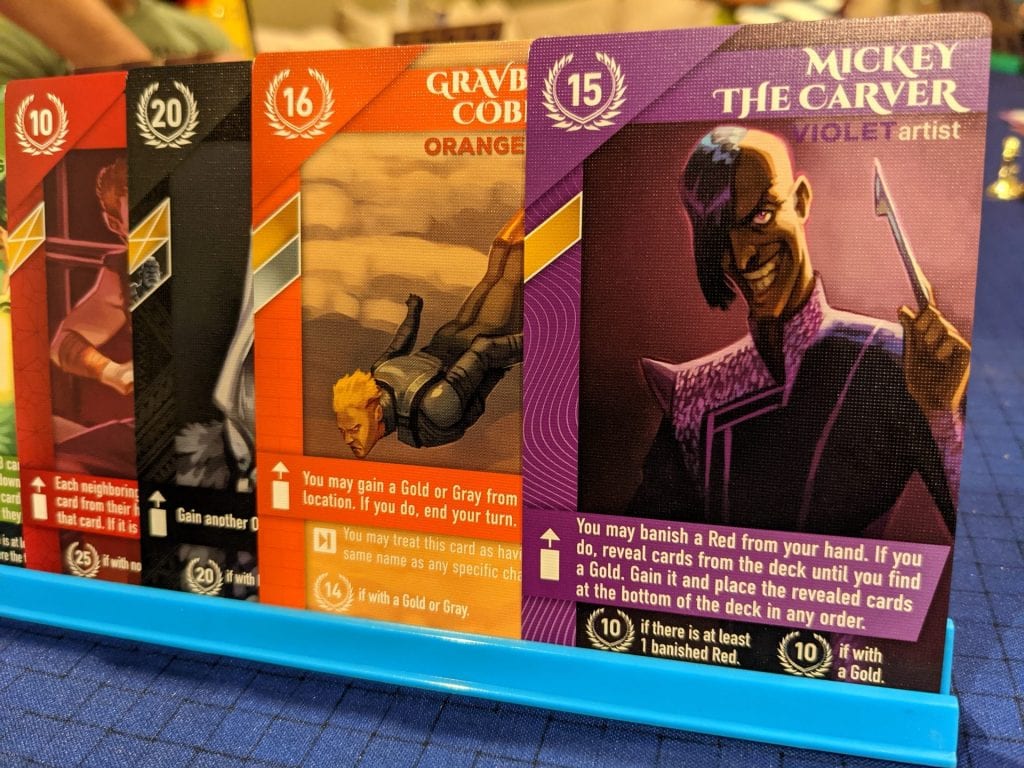
112 Unique Cards!
Red Rising is a hand management game featuring 112 unique character cards in 14 different castes, or suits. Over the course of gameplay, players assume the role of a leader for a specific house from the books. You’ll need to massage a starting hand of five cards into a scoring bonanza that outpaces other players, by playing cards into different areas of the game board to activate card powers and taking cards from other areas of the same board to trigger additional bonuses.
Gameplay is really straightforward; you have a choice of just two actions. The main action is Lead, which requires a player to take one of the cards from their hand and play it on top of any other cards in one section of the board. All cards have a Deploy action; this is activated when a player deploys the card to one of the four card sections of the board.
All 112 cards in Red Rising are unique, so all 112 cards have a unique deploy action. Generally, they allow you to add or banish cards from the board, gain cards that match the played suit from somewhere on the board, take scoring resources called helium from the supply, place influence tokens (cubes) in an area called The Institute, or maybe mess with other players. Sometimes a player won’t be able to take advantage of the Deploy ability, but in most of my games players could usually do at least part of an ability each turn.
The four locations where cards can be deployed are Jupiter, Mars, Luna and The Institute. Once you have deployed a card to one of those four areas, you must take the top card from any of the other three areas where you did not deploy a card on that turn. The location from which you take a card triggers a bonus: The Institute allows you to place an influence token from your supply into the scoring section above that area of the board; Mars lets you take a helium from the supply. Jupiter lets you advance one space on the Fleet Track, which will score increasing amounts of end-game points, and Luna allows the player to grab the Sovereign token, which triggers an additional asymmetrical bonus based on a player’s starting faction.
If you don’t like any of the face-up cards, no sweat; you can draw the top card from the face-down deck and press your luck on what you’ll find. If you do that, you will still get a random bonus from a rolled six-sided die, which align with the same four bonuses granted by the main locations, along with two others: a banish card action to allow you to remove the top card from one of the four stacks, or placing another face-down card in one of the four locations.
If you don’t take the Lead action, you must choose to Scout. If you love your hand and the game is winding down, this is the recommended course of action even in the instruction manual; simply draw the top card of the deck and place it (not Deploy, meaning you don’t get the Deploy benefits if taking the Scout action) on the top of any of the four locations, and take that location’s bonus. In my plays the Scout action does seem to get a decent amount of love late in the game, but I used it occasionally when I had a card in my hand that only triggered its Deploy ability if something specific was going on: maybe I needed possession of the Sovereign token, or the most helium, etc.
The endgame of Red Rising is triggered when all three of the following things happen, or if any one player has completed two of these three events:
- A player has 7 or more helium
- A player has reached the 7 space or higher on the Fleet Track
- A player has 7 or more cubes in The Institute
Players add up the points on their cards, their place on the Fleet Track, points for helium, and points for the number of cubes they have in The Institute. One player will earn a 10-point bonus if they are holding the Sovereign token when the game ends, and a player with more than seven cards will lose 10 points per card past that threshold.
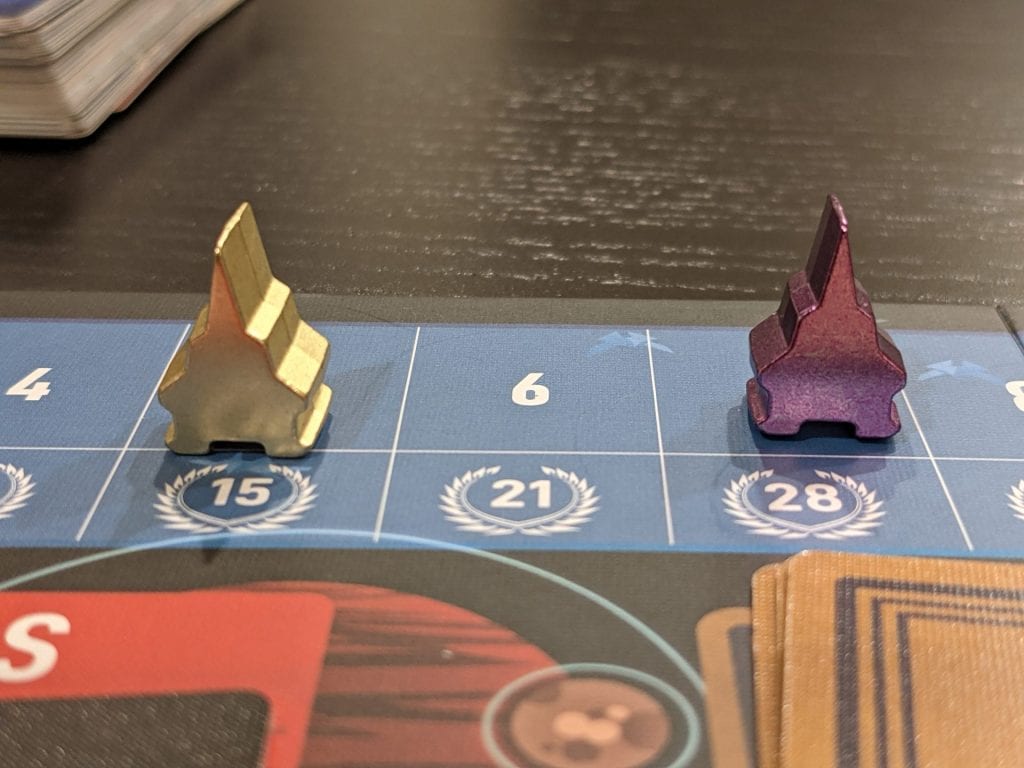
Sounds easy…right?
I’ve tried Red Rising at 2, 3, and 5-player counts. I also played the solo variant three times. The light card game Hats is the hardest short card game I have ever played, but Red Rising now takes the cake.
This is not because Red Rising is difficult. In fact, I love that Red Rising makes gameplay so straightforward and it’s why Scythe and I were such great friends for many years: the turns can be super quick, but feature a lot of strategic depth. After my 5-player game night team skipped the great Watch It Played video for Red Rising, I was forced to teach the game, which took less than 10 minutes. Core gamers will pick this up fast, and the icons are really easy to decipher by the end of your second turn. The player aid basically could teach you 80% of Red Rising on its own, including end-game scoring.
Red Rising is also not difficult because scoring is tricky to explain, at least initially; there are big numbers and laurels around all of the numbers on your cards to help make that part easy. The end-game triggers are very easy to see coming so you can plan a couple of turns ahead as you see the game winding down, and the Scout action lets you settle into your hand late in the game.
Red Rising is the hardest short card game I have ever played because the game’s greatest strength—the amazing cards—is also its biggest weakness:
All 112 cards are different. And in all of my games, I have never seen more than half of the deck played, even my five-player playthrough.
I’m a diversity, equity and inclusion trainer outside of my game reviewer role. So, don’t take this lightly: in Red Rising, diversity is bad. Really bad! (I’ve never in my life thought of diversity as a bad thing, but in this game, it really is.) Card diversity in Red Rising is really difficult to mitigate, for a lot of reasons, although the basis of these problems is quite simple: some of the cards are just universally better than other cards.
I am thankful that all of my city group game players are vaccinated, because to play Red Rising you MUST get up close and personal to hunch yourself directly over the game board to read the small text on all of the cards, particularly the top cards on the four locations because you may want to add one of those to your hand after you have deployed another card.
Also, scoring chains in Red Rising are often tied to giving players additional bonuses for having a specific named card in your hand. Let’s pretend you have The Jackal card. It’s worth 10 points on its own. If you end the game with the Sovereign token, The Jackal is worth 30 more points. However, if you end the game with Darrow or Octavia in your hand, you LOSE 30 points.
You could get around that part, though; you could Deploy Darrow if that card was in your hand if you knew this was the last turn of the game. But what if you have Karnus, worth 15 points straight up? That card will give you a 30-point bonus if you also have Cassius; is it worth spending most of the game looking for that one card?
It is shocking to watch other players struggle even on the first turn, not knowing which cards to keep and which ones to deploy or banish through other card actions. After a couple of games, I began to simply play cards that combo with other abilities well. That same card I mentioned before, The Jackal? A great early-round play, because you could Deploy it to, say, Jupiter, and trigger its Deploy bonus: gain the Sovereign token, which for my player faction might allow me to place a cube at The Institute. Then I could take the top card from Luna, which would trigger the Sovereign bonus again (even if you already have the Sovereign token, this still triggers your faction bonus), allowing me to place a second cube at The Institute all in the same turn.
And, if that card I picked up from Luna combos well with another end-game scoring condition with a card already in hand? Even better. Red Rising really shines in these moments, when you can find the right cards to piggyback on other cards. This is especially true in cases like my 5-player game, when I kept getting cards that allowed me to gain cards without ending my turn, to boost the size of my hand.
Which brings us to something that works fine for me but broke the game for a couple of other players in my various plays: the card draw.

The Luck Factor
I’m not gonna sugarcoat it: I won a couple of games of Red Rising purely out of luck. I knew what to do when I was lucky enough to have the right cards, and that’s certainly a factor. But if you don’t like dice games, strategy games that have event decks, and/or games where there is a 112-card deck of random cards that grant large scoring bonuses if you draw exactly one card, you may want to steer clear of Red Rising.
You might very well start the game with five cards that don’t trigger any deploy bonuses (this has happened once in my plays). You might not like any of the top cards available to add to your hand after a Lead action, forcing you to draw the top card of the deck and roll a die to determine your bonus. In one of my games, I did that on three straight turns because I was looking for a certain color card; I never found the color I wanted, and all three of my die rolls came up with the banish card action, which didn’t help me at all but helped other players immensely.
You might play a game of Red Rising where, on the final turn of the game (we had triggered all three conditions, and I was the last player), I needed either the Nero card or any Orange card to take the place of Nero, since the special ability of all Orange cards is to take the place of exactly one named character for scoring purposes. The player before me, satisfied with his hand, took the Scout action and drew the top card of the deck, placing it on Luna: Nero.
On my turn, I deployed a card that would have given me negative points at game end, then took the Nero card into my hand from Luna, which also gave me the Sovereign token. This swing—I’m not sure it could have been more random!—handed me 65 points: 25 for Nero, 10 points because I ended the game with the Sovereign token, 10 MORE points because Nero got me extra points for having the Sovereign token, and made my Alfrun and Jopho cards worth 10 more points each.
Let’s just say my friends weren’t happy with me when I won the game by 29 points. And there are plenty of examples like this which will certainly happen during games; this lands Red Rising firmly in game of chance territory, not a strategic endeavor like I am used to with the other Stonemaier games I have played. (I would put Red Rising closer to Wingspan than Scythe, in terms of weight.)
And that’s fine with me, as long as you manage expectations.
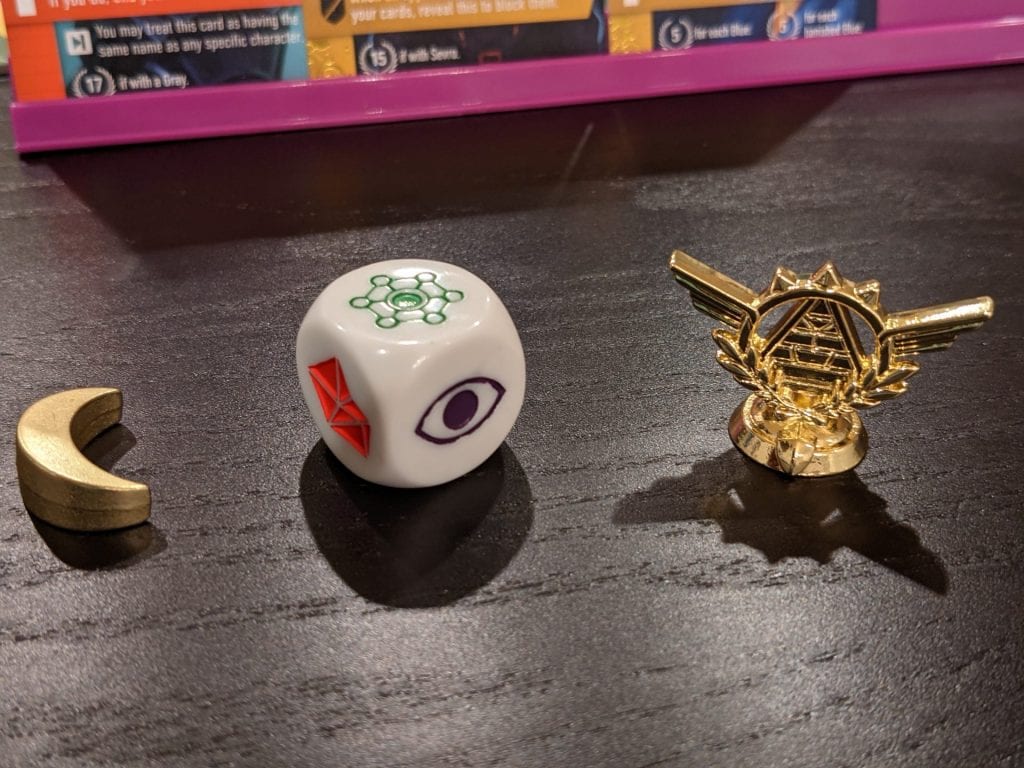
The production
Red Rising Collector’s Edition is nice, really nice. The weight of the faction cubes, the Fleet Track marker, the Sovereign token…amazing. The box includes card holders so you never have to even put the cards in your (or maybe just my?) filthy hands, keeping the quality of these in pristine condition and allowing players to study them between turns, which you’ll be doing in spades.
I don’t normally sleeve cards, but I can see the value in sleeving the cards of Red Rising, especially the Gold suit because they look so good! The 21 Gold cards in the deck have gold foil along the edge; they just look and feel incredible. (The other 13 suits have 7 cards each; this isn’t listed on the player aid, but for planning purposes and scoring chances, keep that in mind.)
I’m just not sure you would need this version at the current price point. At the end of the day, Red Rising is a card game that plays in under an hour if you are playing with 1-4 players, about 90 minutes at 5-6 players. (Experienced groups will knock this out in under an hour even at 6 players but that would require a group that really knows all of the cards!)
The major downside of the production: the card colors. There are Gold cards and Yellow cards. There are Gray cards and Silver cards. Obsidian (Black) cards are the color black, for sure, but the word Obsidian can’t be seen from a couple feet away because the black is so black on those cards. All of the cards are well labeled, meaning the word Gray is printed front and center on Gray cards, but the colors are very similar. There are very light touches to signify different suits but not as prominent as the colors.
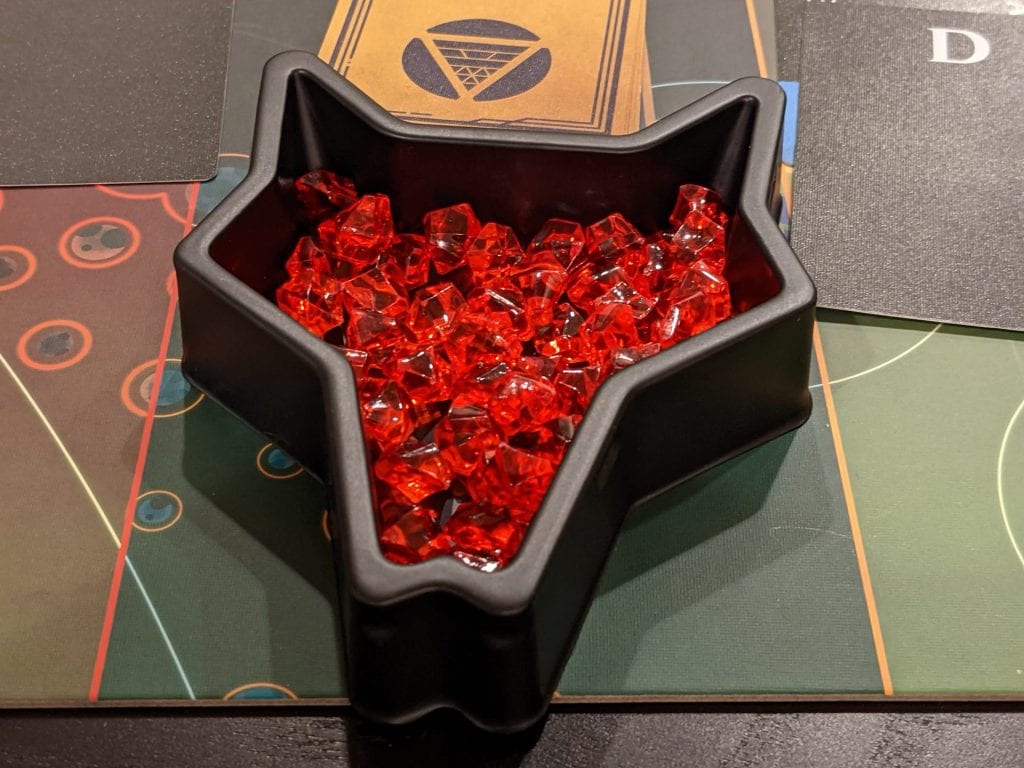
Wait, isn’t this based on a book series?
Ahh, right; I meant to provide more on this earlier. There is essentially no story for Red Rising the game. For those who know the books well, you will have plenty of fun moments looking at the visual representation of the characters you remember from the story. “Ahh, cool, Mickey the Carver!” I said to no one in particular when I drew that card from a top-deck draw action. It took a few plays, but I finally drew the Sevro card; seeing what card it is paired with made sense to me, but it didn’t really matter as it relates to gameplay. I have still never drawn it during a game, but I like the Mustang card and understand why it pairs the way it does.
I wish my institutional knowledge meant more to the gameplay in Red Rising.
The story (at least for the one book I’ve read) is fantastic; there’s just none of that story here. In reading the notes from the instruction manual and doing a little digging online, the game Red Rising is mechanically similar to one of this year’s Kennerspiel nominees, Fantasy Realms, but I’m guessing that there is really no story in either game.
This is a disappointment as a reader, but if the goal was to get a streamlined experience, Red Rising achieves that. In my perfect world, Scythe gets reskinned with the Red Rising license and turned into a skirmish game, like the final two-thirds of the first book; having the various houses fight it out, taking prisoners, raiding home bases, exploiting the environment by hiding inside of horses to spring traps (spoiler alert!)…all of that would have been a blast.
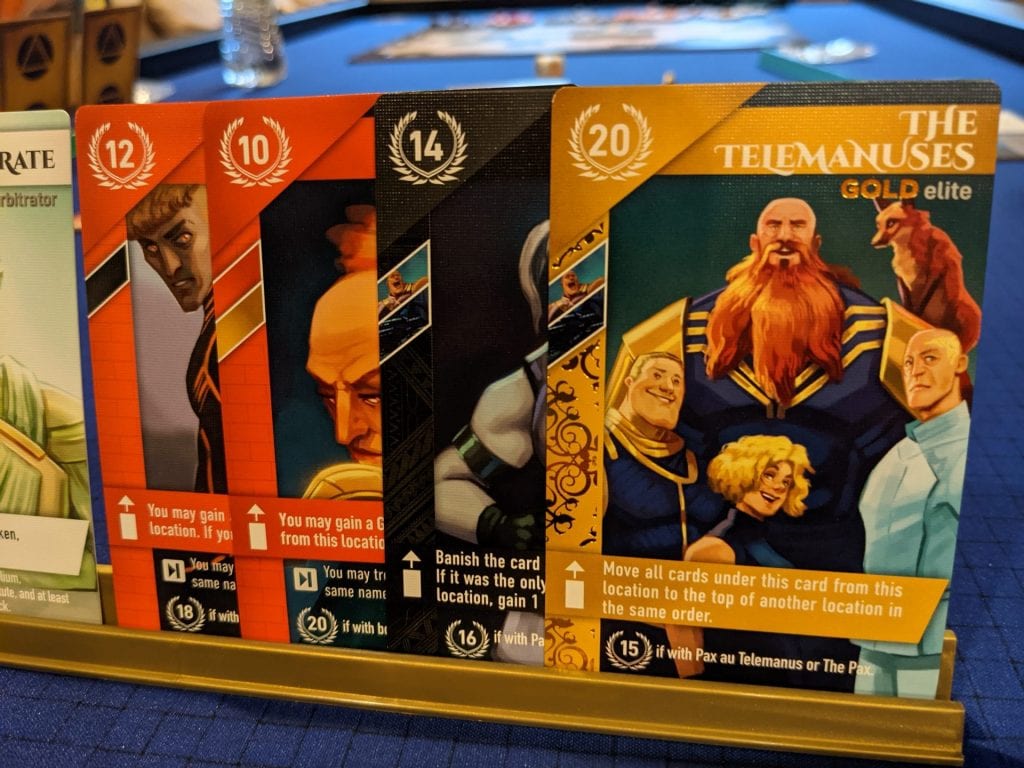
Final Thoughts
Red Rising is a fine game, just not a game that aligns as closely to the book series as I had hoped. Introducing the game as a game of chance will pay dividends with your group; the person with the biggest hand has always won my plays and if you don’t get cards with the “gain” ability—that allow you to end your turn with one more card than you started with—you are going to lose, period.
The production of the Red Rising Collector’s Edition is amazing; like other Stonemaier Games products, you won’t leave disappointed in this respect. And while I didn’t love the gameplay, my games of Red Rising never overstayed their welcome, embracing simplicity and a breezy experience that generally plays in under an hour.
I was really curious about this one so I’m glad I got to experience the game. Now if you’ll excuse me, I’m off to read the second novel in the series!


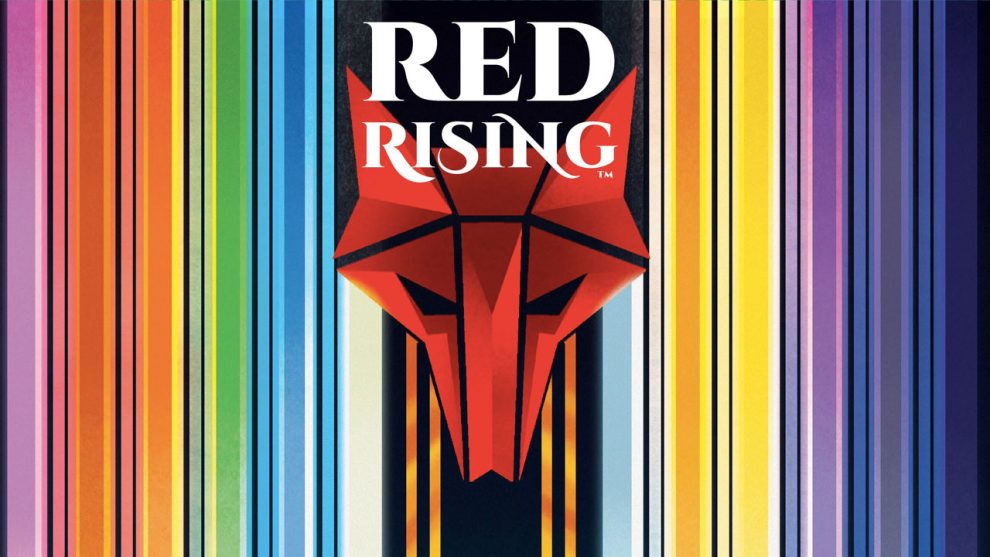









Very good review. I have the game, but have yet to be able to get a group that would let me put this one on the table. 🙁
Finally played a game. Your review (at least for a two player game) is spot on.
Thanks for the feedback David!